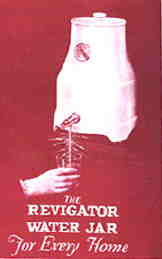Radiation? A health tonic! The history of L.A.’s radium rage
By Michael Collins
Los Angeles CityBeat/ValleyBeat — August 5, 2006
 Once upon a time in the City of Angels, radioactive products made with lethal yet luminous radium became a health rage. Wondrous radium, which cost $1 million an ounce in the 1920s, was commonly prescribed by physicians to treat cancer, heart trouble, impotence, ulcers, depression, arthritis, high blood pressure, tuberculosis, and blindness. Along with various concoctions of “pitch blend” – a mix of radium and uranium – these radioactive products fit well into the Southern California lifestyle, which touted its dry climate and clean air as the ultimate healthy environment.
Once upon a time in the City of Angels, radioactive products made with lethal yet luminous radium became a health rage. Wondrous radium, which cost $1 million an ounce in the 1920s, was commonly prescribed by physicians to treat cancer, heart trouble, impotence, ulcers, depression, arthritis, high blood pressure, tuberculosis, and blindness. Along with various concoctions of “pitch blend” – a mix of radium and uranium – these radioactive products fit well into the Southern California lifestyle, which touted its dry climate and clean air as the ultimate healthy environment.
This, of course, was before the deadly effects of radiation were well documented. The discovery of x-rays in 1895 led directly to Henri Becquerel’s detection of the radioactivity of uranium in 1896 and then to the discovery of radium by Marie and Pierre Curie in 1898, for which Becquerel and the Curies shared the Nobel Prize in 1903.
Zimmer Laboratories of Los Angeles concocted the Zimmer Radium Emanator, a six-inch porous cone designed to soak overnight in water, infusing it with radioactivity. The company made 5,000 to 10,000 of these devices and noted that “cone water is fortified with nature’s radio-activity, the life of every living thing called Vitamin D [sic]. Children who drink this water will probably never have ulcers, tumors, cancers, or goiter.” Through the 1940s and 1950s, the company continued producing the Zimmer Radon Generator, which produced radon, a deadly, gaseous by-product of radium.
Radium Life, Inc. of Los Angeles made the Radium Emanator, a wacky-looking device with five disks of pitch blend on a pole that added radium to drinking water. The Radium Appliance Company of Los Angeles manufactured the Radio-Active Solar Pad, touting its miraculous powers: “When applied to the body, the pad immediately begins to discharge this energy into the system, sending the life-giving current through the blood and nervous system.”
Thousands of people drank radium-laced bottled water as an all-purpose elixir known popularly as “liquid sunshine.” As recently as 1952, Life magazine wrote about the healthy effects of inhaling radioactive radon gas in deep mines. Even today, the Merry Widow Health Mine near Butte, Montana and the nearby Sunshine Radon Health Mine advertise that visitors to the mines report multiple benefits from inhaling radioactive radon. Radon gas, however, has been most commonly linked to lung cancer.
For her troubles, Madame Curie would die of acute lymphoblastic leukemia in 1934 after exposure to radium and other radioactive substances. Even her century-old scientific notebooks are still so radioactive that they are too dangerous to touch.












Recent Comments